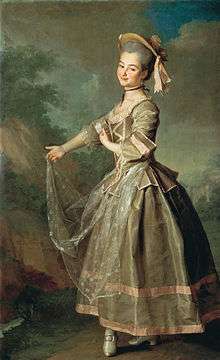La serva padrona
| Giovanni Battista Pergolesi |
|---|
|
Operas
|
La serva padrona (The Servant Turned Mistress) is an opera buffa by Giovanni Battista Pergolesi (1710 – 1736) to a libretto by Gennaro Antonio Federico, after the play by Jacopo Angello Nelli. The opera is only 45 minutes long and was originally performed as an intermezzo between the acts of a larger serious opera. (The same libretto was set by Giovanni Paisiello in 1781.)
Performance history
La serva padrona was originally an intermezzo to Pergolesi's opera seria, Il prigionier superbo (The Proud Prisoner). The two were premiered on 5 September 1733, the first performance after an earthquake in Naples had caused all theatres to be closed, and celebrated the birthday of the Empress of Habsburg.
Il prigioniero superbo was unsuccessful in its day[1] and is not a recognized title in today’s operatic repertoire. Eventually the two pieces were separated, and La serva padrona went on to enjoy fame throughout Europe for years after its premiere. The importance of this intermezzo can hardly be overlooked in the history of opera. With a new finale, the French version played a large part in the Querelle des Bouffons. It was appealing because of its presentation of characters that were relatable to any audience, namely the cunning maid and her aging master. La serva padrona is often seen as the quintessential piece that bridges the gap from the Baroque to the Classical period. Owing to its importance, over time it came to be known as more than just an intermezzo and was performed as a stand-alone work.
Roles
| Role | Voice type | Premiere cast[2] 5 September 1733 |
|---|---|---|
| Uberto, an old man | buffo bass | Gioacchino Corrado |
| Serpina, his maid | soprano | Laura Monti |
| Vespone, his servant | silent actor |
Synopsis

Dressing room
Uberto, an elderly bachelor, is angry and impatient with his maidservant, Serpina, because she has not brought him his chocolate today. Serpina has become so arrogant that she thinks she is the mistress of the household. Indeed, when Uberto calls for his hat, wig and coat, Serpina forbids him from leaving the house, adding that from then on he will have to obey her orders. Uberto thereupon orders Vespone to find him a woman to marry so that he can rid himself of Serpina.
Intermezzo 2
Same dressing room
Serpina convinces Vespone to trick Uberto into marrying her. She informs Uberto that she is to marry a military man named Tempesta. She will be leaving his home and apologizes for her behavior. Vespone, disguised as Tempesta, arrives and, without saying a word, demands 4,000 crowns for a dowry. Uberto refuses to pay such a sum. Tempesta threatens him to either pay the dowry or marry the girl himself. Uberto agrees to marry Serpina. Serpina and Vespone reveal their trick; but Uberto realizes that he has loved the girl all along. They will marry after all; and Serpina will now be the true mistress of the household.
Recordings
- Virginia Zeani opposite her husband Nicola Rossi-Lemeni (1959)
- Renata Scotto and Sesto Bruscantini (c1960)
- Anna Moffo and Paolo Montarsolo (1962)
- Maddalena Bonifacio and Siegmund Nimsgern (with Collegium Aureum in Deutsche Harmonia Mundi) (1969)
- Carmen Bustamante and Renato Capecchi (1973)
- Julianne Baird and John Ostendorf (1989)
- Mariella Adani and Leonardi Monreale, Pomeriggi Musicali del Teatro Nuovo di Milano, Ettore Gracis cond.; Nonesuch H-71043 (c1960s)
- Patricia Biccire and Donato Di Stefano, La Petite Bande cond. Sigiswald Kuijken Accent ACC 96123 D (1996)
- Gordana Minov-Jevtović and Nikola Mitić, PGP RTB (1976)
Scores
The scores of the opera vary wildly. Edwin F. Kalmus has a score with massive omissions, wrong notes, and much spoken dialogue. Boosey & Hawkes has the score in an operetta adaptation by Seymour Barab, with highly simplified accompaniment and much spoken dialogue. Casa Ricordi presents the opera as sung-through and is the version most used in performance today. W.W. Norton & Company includes excerpts of the full score (for strings and continuo) that has numerous melodic differences from the Ricordi edition, but that correlate with the accompanying recording by Siegmund Nimsgern.[3]
Film versions
- Italian director Mario Lanfranchi made an opera-film version in 1958 with Anna Moffo, Paolo Montarsolo, and Giancarlo Cobelli.[4]
- Brazilian director Carla Camurati made a feature film version in 1999 with Sylvia Klein (Serpina), José Carlos Leal (Uberto) and Thales Pan Chacon (Vespone).[5]
References
- Notes
- ↑ Grout and Williams (2003), p. 232
- ↑ "Almanacco 5 September 1733" (in Italian). AmadeusOnline. Retrieved 27 August 2010.
- ↑ Palisca, pp. 1–15
- ↑ La serva padrona on IMDB
- ↑ International Festival of Audiovisual Programs (FIPA). La serva padrona
- Sources
- Grout, Donald Jay and Hermine Weigel Williams (2003), A Short History of Opera, Columbia University Press, pp. 229–232. ISBN 0-231-11958-5
- Palisca, Claude V. Norton Anthology of Western Music: Volume 2: Classic to Modern. New York: W.W. Norton, 2001 ISBN 0-393-97691-2
- Warrack, John and Ewan West (1992) The Oxford Dictionary of Opera. ISBN 0-19-869164-5
External links
Librettos
- Federico, Gennaro Antonio (1739). La serva padrona. Intermezzo per musica da rappresentarsi nel teatro formagliari il Novembre 1739. Bologna: Bayerische StaatsBibliothek digital. Retrieved 13 January 2013.
- Federico, Gennarantonio. "La Serva Padrona. Intermezzo in due parti". www.librettidopera.it. Retrieved 13 January 2013.
Scores
- Pergolesi, Giovanni Battista (1757). La serva padrona. Intermezzo del Signore Giovanni Battista Pergolese rapresentato in Pariggi nell' Autunno 1757 (1805 by Auguste Le Duc, reprint ed.). Paris: Radicciotti-Cherbuliez. Retrieved 13 January 2013. at UNT
- Various editions at IMSLP
|